Chapter 6 Anatomy of Flowering Plants
Class 11th Biology NCERT Book Solution
NCERT Solutions For Class 11 Biology Anatomy of Flowering Plants
Topics and Subtopics in NCERT Solutions for Class 11 Biology Chapter 6 Anatomy of Flowering Plants:
NCRT TEXTBOOK QUESTIONS SOLVED
1.State the location and
function of different types of meristems.
Soln.
Meristems are of three types on the basis of their location in plant body:
(i) Apical meristem: It is present at the apices of root and shoot and is
responsible for increase in length.
(ii)Intercalary meristem: It is present
at the bases of leaves above the nodes or below the nodes and is responsible for
elongation of the organs.
(iii)Lateral meristem : It is present on lateral
side and is responsible for increase in girth or diameter.
2.Cork cambium forms tissues
that form the cork. Do you agree with this statement?
Explain.
Soln. Yes, I agree with
this statement. Cork cambium cuts off cells both on its outer side and inner
side. The cells cut off on outer side form cork and cells cut off on inner side
form secondary cortex. The cells of cork are dead whereas those of secondary
cortex are living.
3.Explain the process of
secondary growth in the stems of woody angiosperms with the help of schematic
diagrams. What is its significance?
Soln.
Secondary growth is the formation of secondary tissues from lateral
meristems. It is found in dicots only. It increases the diameter of the stem.
Secondary tissues are formed by two types of lateral meristems, vascular cambium
and cork cambium. Vascular cambium produces secondary vascular tissues while
cork cambium forms periderm.The vascular bundles in dicot stem are conjoint,
collateral, open and are arranged in a ring. The cambium present between xylem
and phloem in vascular bundles is called fascicular or intrafascicular cambium.
Besides this, some cells of medullary rays also become meristematic and this is
called interfascicular cambium. Both these cambia collectively constitute
complete ring of vascular cambium. This ring of vascular cambium divides
periclinally to cut off cells both on inner side and outer side. The cells cuts
off on outer side are secondary phloem and inner side are secondary xylem.
Amount of secondary xylem cut off is more than secondary phloem and thus with
the formation of secondary tissue, increase in girth or diameter occurs. The
structure of secondary xylem and secondary phloem is similar to that of primary
xylem and primary phloem. With the increase in secondary tissue, the primary
xylem and primary phloem get crushed. The ray initials of vascular cambium ring
divide by tangential divisions and add new cells. These new cells produced on
both the sides of ray initials remain meristematic for sometime and then
differentiate into parenchymatous cells of rays. The rays, produced by vascular
cambium in between the secondary xylem and secondary phloem, are called
secondary medullary rays. They are usually one to few layers in thickness and
one to several layers in height. The medullary rays form the radial systejn
responsible for radial conduction of solutes. They maintain connection between
pith and cortex There is a marked difference in activity of cambium with change
in season. In spring, the activity of cambium is more and hence the wood
elements are larger in size with wide lumen. The activity of cambium is less
during autumn and the wood elements are smaller in size with narrow lumen.
Spring wood and autumn wood of a year constitute annual ring.
In order to
increase in girth and prevent harm on the rupturing of the outer ground tissues
due to the formation of secondary vascular tissues, dicot stems produce a cork
cambium or phellogen in the outer cortical cells. Phellogen cells divide on both
the outer side as well as the inner side to form secondary tissues. The
secondary tissue formed on the inner side is called secondary cortex while the
tissue formed on outer side is called cork.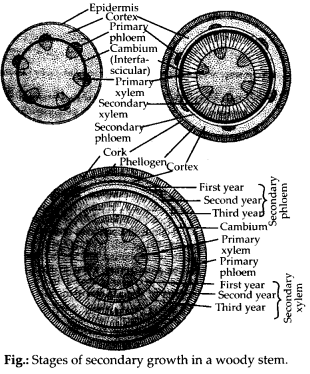
Significance of secondary growth is as
follows:
(i) It
adds to the girth of the plant thus provides support to increasing weight of
aerial parts due to growth.
(ii)It’ produces a corky bark around the tree
trunk that protects the interior from abrasion, heat, cold and infection.
(iii)It adds new vascular tissues for replacing old non-functioning one as well
as for meeting increased demand for long distance transport of sap and organic
nutrients.
4.Draw illustrations to bring
out the anatomical difference between
(a) Monocot root and dicot root
(b) Monocot stem and dicot stem
Soln.(a)
Differences between monocot root and dicot root are illustrated in the following
figure and table.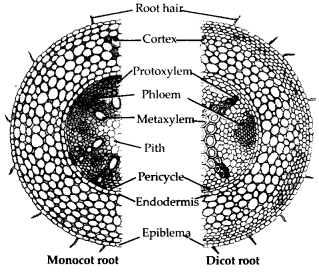
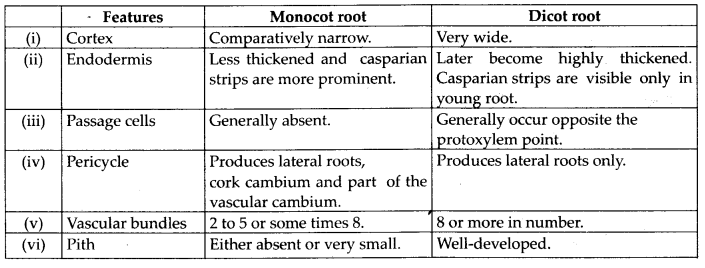
(b) Differences between monocot and dicot stems are
illustrated in the following figure and table.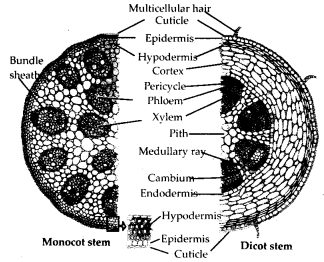
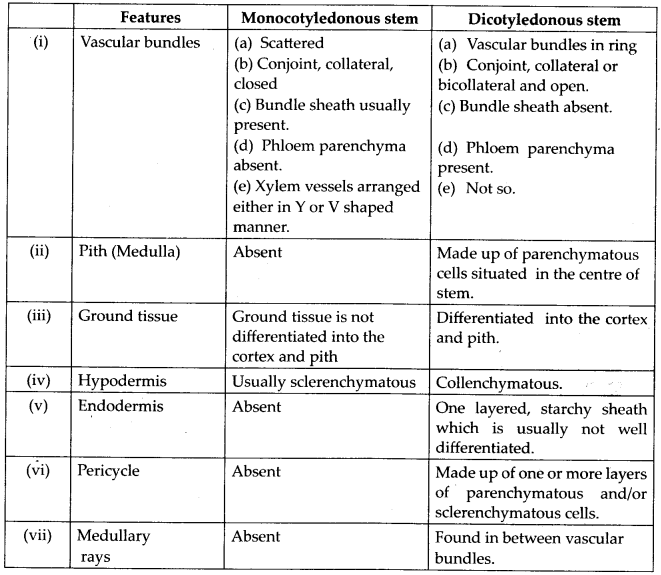
5.Cut a transverse section of
young stem of a plant from your school garden and observe it under the
microscope. How would you ascertain whether it is a monocot stem or a dicot stem
? Give reasons.
Soln. Vascular bundles in
dicot stem are arranged in a ring whereas in monocot stem vascular bundles are
scattered throughout the ground tissue. On the basis of arrangement of vascular
bundles it can be ascertained
whether the young stem is dicot or monocot.
Besides undifferentiated ground tissue, sclerenchymatous hypodermis, oval or
circular vascular bundles with Y shaped xylem are other differentiating features
of monocot stem.
6.The transverse section of a
plant material shows the following anatomical features – (a) the vascular
bundles are conjoint, scattered and surrounded by a sclerenchymatous bundle
sheath, (b) phloem parenchyma is absent. What will you identify it
as?
Soln. The plant material
is identified as monocot stem.
7.Why are xylem and phloem
called complex tissues?
Soln. A group of
different types of cells which perform common function is called complex tissue.
Xylem and phloem are called complex tissues as all cells that work as a unit for
a common function have different structural organisation. Xylem has four types
of cells-tracheids, vessels, xylem parenchyma and xylem fibres. Phloem consists
of sieve tube elements, companion cells, phloem parenchyma and phloem fibres.
Xylem is associated with conduction of water and minerals from roots to top of
plants and phloem is responsible for transport of organic food.
8.What is stomatal apparatus?
Explain the structure of stomata with a labelled
diagram.
Soln.Stomata are
structures present in the epidermis of leaves. Stomata regulate the process of
transpiration and gaseous exchange. Each stoma is composed*of two bean shaped
cells known as guard cells which enclose stomatal pore. The outer walls of guard
cells (away from the stomatal pore) are thin and the inner walls (towards the
stomatal pore) are highly thickened. The guard cells possess chloroplasts and
regulate the opening and closing of stomata. Sometimes, a few epidermal cells,
in the vicinity of the guard cells become specialised in their shape and size
and are known as subsidiary cells. The stomatal aperture, guard cells and the
surrounding subsidiary cells are together called stomatal apparatus.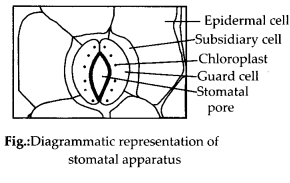
9.Name the
three basic tissue systems in the flowering plants. Give the tissue names under
each system.
Soln. The three basic
tissue systems in flowering plants are epidermal tissue system, ground tissue
system and vascular tissue system.
Epidermal tissue system comprises
epidermal cells, stomata, trichomes and hairs.
Ground tissue system consists
of cortex, endodermis, pericycle, pith and medullary rays, in the primary roots
and stems. In¬leaves, the ground tissue consists of thin walled chloroplast
containing cells and is called mesophyll.
The vascular tissue system consists
of complex tissues, the phloem and the xylem.
10.How is the study of plant
anatomy useful to us?
Soln. Study of internal
structures of plants is called plant anatomy. Study of plant anatomy is
useful:
-for solving taxonomic problems.
-for knowing homology and analogy
of various plant groups.
-to differentiate the superior and inferior,
standard and substandard or specified and unspecified woods.
-in establishing
purity and correct identity of plant parts in pharmacognosy (science connected
with sources, characteristics and possible medicinal uses).
-in knowing the
structural peculiarities of different groups of plants.
11 .What is periderm? How
does periderm formation take place in the dicot stems?
Soln. phelloderm,
phellogen and phellem together constitute the periderm. Periderm is protective
in function.Dicot stems produce cork cambium or phellogen in the outer cortical
cells. Phellogen cells divide on both the outer side as well as the inner side
to form secondary tissues. The secondary tissue produced on the inner side of
the phellogen is called secondary cortex or phelloderm. On the outer side
phellogen produces cork or phellem.
12.Describe the internal structure of a dorsiventral leaf with the help of
labelled diagram.
Soln.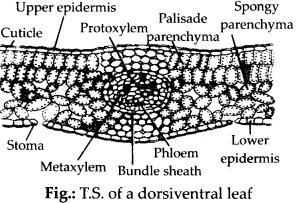
Dorsiventral leaves are found in dicots. The important
anatomical features of dorsiventral leaves are discussed below:
(a) Upper
epidermis : This is generally outermost single layer made of parenchymatous
cells. The epidermal cells have sometimes outgrowths called papillae, e.g., in
Gladiolus. The epidermal cells are devoid of chloroplast and stomata are absent
on upper epidermis.
(b) Lower epidermis : It is just like upper epidermis but
here stomata are present. Chloroplasts are absent in lower epidermis also,
except the guard cells of stomata.
(c)Mesophyll: In between upper and lower
epidermis mesophyll tissue is present which can be divided into two regions:
(i)Palisade parenchyma : These are elongated columnar cells without
intercellular spaces. These have chloroplast in them and are generally arranged
in two layers.
(ii)Spongy parenchyma : It is found below palisade parenchyma
and are spherical or oval with intercellular spaces. They also have chloroplasts
but number of chloroplasts is more in palisade parenchyma than spongy
parenchyma.
(d)Vascular bundles : Vascular bundles are. generally found at
the boundary between the palisade and the spongy regions. The vascular bundle in
midrib region is largest. Vascular bundles are conjoint, collateral and closed.
Each vascular bundle is surrounded by a bundle sheath of parenchymatous cells.
In the vascular bundle, xylem is present towards upper epidermis and phloem
towards lower epidermis. Further in xylem, protoxylem is towards upper
epidermis.